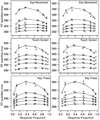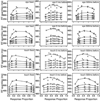Pointing, looking at, and pressing keys: A diffusion model account of response modality
- PMID: 26322685
- PMCID: PMC4666812
- DOI: 10.1037/a0039653
Pointing, looking at, and pressing keys: A diffusion model account of response modality
Abstract
Accumulation of evidence models of perceptual decision making have been able to account for data from a wide range of domains at an impressive level of precision. In particular, Ratcliff's (1978) diffusion model has been used across many different 2-choice tasks in which the response is executed via a key-press. In this article, we present 2 experiments in which we used a letter-discrimination task exploring 3 central aspects of a 2-choice task: the discriminability of the stimulus, the modality of the response execution (eye movement, key pressing, and pointing on a touchscreen), and the mapping of the response areas for the eye movement and the touchscreen conditions (consistent vs. inconsistent). We fitted the diffusion model to the data from these experiments and examined the behavior of the model's parameters. Fits of the model were consistent with the hypothesis that the same decision mechanism is used in the task with 3 different response methods. Drift rates are affected by the duration of the presentation of the stimulus while the response execution time changed as a function of the response modality.
(c) 2015 APA, all rights reserved).
Figures




Similar articles
-
Neural correlates of evidence accumulation in a perceptual decision task.J Neurophysiol. 2011 Nov;106(5):2383-98. doi: 10.1152/jn.00413.2011. Epub 2011 Aug 17. J Neurophysiol. 2011. PMID: 21849612
-
The effect of directional compatibility on the response latencies of ocular and manual movements.Exp Brain Res. 2005 Apr;162(2):220-9. doi: 10.1007/s00221-004-2146-0. Epub 2004 Dec 15. Exp Brain Res. 2005. PMID: 15599726
-
A random-walk model of accuracy and reaction time applied to three experiments on pigeon visual discrimination.J Exp Psychol Anim Behav Process. 2011 Apr;37(2):133-50. doi: 10.1037/a0021656. J Exp Psychol Anim Behav Process. 2011. PMID: 21517198
-
Physiological evidence for response inhibition in choice reaction time tasks.Brain Cogn. 2004 Nov;56(2):153-64. doi: 10.1016/j.bandc.2004.06.004. Brain Cogn. 2004. PMID: 15518932 Review.
-
Reward-dependent learning in neuronal networks for planning and decision making.Prog Brain Res. 2000;126:217-29. doi: 10.1016/S0079-6123(00)26016-0. Prog Brain Res. 2000. PMID: 11105649 Review.
Cited by
-
Comparing fixed and collapsing boundary versions of the diffusion model.J Math Psychol. 2016 Aug;73:59-79. doi: 10.1016/j.jmp.2016.04.008. Epub 2016 May 24. J Math Psychol. 2016. PMID: 28579640 Free PMC article.
-
Not all observed actions are perceived equally.Sci Rep. 2017 Dec 6;7(1):17084. doi: 10.1038/s41598-017-17369-z. Sci Rep. 2017. PMID: 29213067 Free PMC article.
-
Delta plots for conflict tasks: An activation-suppression race model.Psychon Bull Rev. 2021 Dec;28(6):1776-1795. doi: 10.3758/s13423-021-01900-5. Epub 2021 Jul 29. Psychon Bull Rev. 2021. PMID: 34327678 Review.
-
The diffusion model visualizer: an interactive tool to understand the diffusion model parameters.Psychol Res. 2020 Jun;84(4):1157-1165. doi: 10.1007/s00426-018-1112-6. Epub 2018 Oct 25. Psychol Res. 2020. PMID: 30361811 Free PMC article.
-
The validity and consistency of continuous joystick response in perceptual decision-making.Behav Res Methods. 2020 Apr;52(2):681-693. doi: 10.3758/s13428-019-01269-3. Behav Res Methods. 2020. PMID: 31270793 Free PMC article.
References
-
- Brown S, Heathcote A. A ballistic model of choice response time. Psychological Review. 2005;112:117–128. - PubMed
-
- Busemeyer JR, Townsend JT. Decision field theory: A dynamic-cognitive approach to decision making in an uncertain environment. Psychological Review. 1993;100:432–459. - PubMed
-
- Diederich A, Busemeyer J. Simple matrix methods for analyzing diffusion models of choice probability, choice response time, and simple response time. Journal of Mathematical Psychology. 2003;47(3):304–322.
-
- Gold J, Shadlen M. Neural computations that underlie decisions about sensory stimuli. Trends in Cognitive Sciences. 2001;5(1):10–16. - PubMed
Publication types
MeSH terms
Grants and funding
LinkOut - more resources
Full Text Sources
Other Literature Sources

